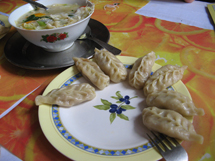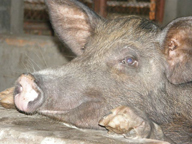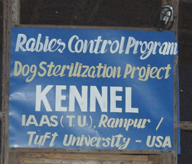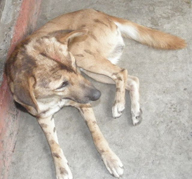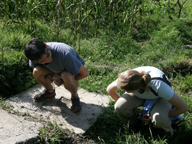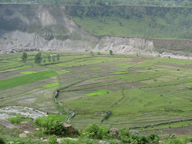If you have any questions or would like further information, please contact Laurel Redding at lredding@vet.upenn.edu.
By Laurel Redding
Our trip is now over and we are back in the US. We have had a bit of time to digest and reflect, and it seems to me that, while our trip was exciting and worthwhile, it has raised more questions than it answered!
The overall goal of our trip – and of this project – was to determine how we, as veterinarians, can make a unique contribution to the improvement of animal health and productivity on small farms, where, research has shown, the greatest potential for hunger and poverty alleviation exists. If there is one thing we learned on this trip, it was that this goal has many obstacles and challenges facing it. Nepal is one of the world’s poorest countries and suffers from a number of “development traps” (described by Paul Collier in The Bottom Billion: Why the Poorest Countries are Failing and What Can Be Done About It), including being a completely landlocked country with unstable governance. Nepal is highly dependent upon its neighbor, India, and one of the largest sources of income is from Nepalis working abroad and sending money home. The younger, more educated generation seeks to go abroad for a better life – education, for them, is a means of escape. There is also somewhat of a resigned attitude among Nepali with regards to the future of their country.
I have come to believe that any changes that will be made will be done so at the grassroots level – that of the village or the family unit. From this angle, there is great potential for change, and the work of Heifer International in Nepal clearly demonstrates this. Nepal is one of Heifer’s greatest success stories: village community groups that form are, in general, very successful and, what’s more, go on to form more village groups. The village we stayed in was a Heifer community. Our neighbor had received Heifer goats and had already participated in several Passing On the Gift ceremonies.
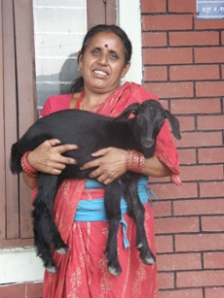
One of the women from our villagers who had received Heifer goats and had participated in Passing On the Gift ceremonies – she is now a member of the village’s women’s community.
Our village women’s group had done really great things for the village, including building a community center (where our training sessions took place) and starting microfinance ventures for members of the village. Heifer’s models of success depend on two very important factors – a strong-knit community with shared aspirations and a spirit of cooperation, and the presence of community leaders. In that respect, working with AHTCS to train Village Animal Health Workers is a very worthy activity for veterinarians to be involved in, as VAHWs usually become community leaders, and, what’s more, tend to stay in their community.

VAHWs, like this one from one of the villages we visited, become effective community leaders. They were all eager to help us with our work, hoping we can help have a positive impact on their village.
Perhaps another factor we need to take into consideration for this project is our definition of success. Our society clearly values efficiency, progress, high productive output, and measurable indicators of success. Perhaps this project will require a different perspective – different metrics of success. Perhaps a small difference made in individual lives or families will have a far greater overarching effect than it would in the developed world. At any rate, we look forward to continuing the project and to apply what we learned on this trip to making a contribution to livestock health and productivity.
By Yoon Chay
It has been one week in Seoul, and I have been fully enjoying the elements of modern civilization – hot shower, a soft bed, AC, internet, TV, coffee, safe public transportation, few bug bites. It is nice to spend time with my family and friends and be physically comfortable. However, there is something missing in this city – a simple form of life.
When there is not enough running water in Nepal, people collect rain water for cooking and bathing. When electricity goes out at night, they go to bed early. Children do not need a playstation or fancy toys to have fun. They play volleyball or football (ok, ok, I know you Americans call it soccer) with flip flops. When there is not enough of something, you just live with the shortage. As long as they have enough food to feed their family, people seem satisfied. All these sound very basic and inconvenient, but for some reason I miss this simple life style in which I was able to smile quite often and rarely get stressed about anything except spicy pepper, bug bites, and Korean football team losing to Uruguay.
Life is just a lot more complicated in the US or Seoul – school, family, friends, emails, Facebook, credit cards, cell phones, TV, news, and etc. There are just too many things to meet and people to do – higher expectations I have to fulfill everyday. At the moment, I am little confused whether these elements of complicated modern life actually make me and other people happier than ones in Nepal. I miss Nepal, its people, and its simple life. Dah-dah (bye), Nepal, for now. I will be back!
By Lauren Aldinger
For those not quite yet fluent in Nepalese after this blog series (just kidding!), the title means “Thank you and Goodbye!” Alas, our wonderful journey has come to a close and we have all arrived safely at our next destination. The trip can hardly be summarized in one concise blog posting, so I will remain true to my favorite blog style (lists baby lists!) and briefly describe what I will most miss about Nepal.
1. The People. Hands-down this is the first item that comes to mind. From the beginning, the Nepalese have opened their homes and hearts to our presence and sought to give us the best Nepali experience possible. They certainly delivered (far beyond expectation!) and have left a sizeable imprint on our hearts. From their comical phrases to their easy-going attitude, they have taught us that not everything (wink wink) needs a ‘why’ explanation and that short-cuts are not necessarily the fastest means to success. Personally, I am already missing my accompanying classmates very much as well. Thank you Laurel and Yoon for an awesome experience!
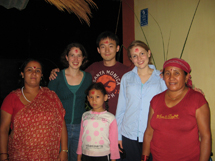
Less than 48 hours upon our arrival, we were invited into a villager’s home to dance and celebrate life! We were adorned with tikas of course!
2. The Landscape. One word: WOW. From the elephants in the jungle to yaks on those majestic snowy mountains, Nepal has it all. On a daily basis I felt as if I were either meandering throughout Longwood Gardens, plunked down in the Amazon, or skiing down the Alps in Europe. We even had a topography lesson and learned that mountains must have snow on top- everything else is considered a hill!
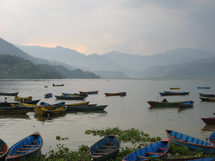
From Fewa Lake to Macchapucchre of the Annapurna mountain range our eyes were treated to a royal feast!
3. The Food. While it’s true that I lost my fancy for daal (lentils) early on, I did really appreciate the simplicity of the meals, seemingly endless supplies of baat (rice), and spicy potatoes. Already less than a week back in the States, I’m longing for the many tasty vegetarian dishes offered in Nepal even though I am traditionally a big fan of meat and dairy products. This has left me screaming, “Bhog lagyo!” (I am hungry!)
4. Football. Now I can’t believe I am actually publically admitting this, but I have already grown nostalgic about the times we spent watching World Cup games in the evenings. Symptoms include 1) dodging into a nearby café in Ithaca to check the score of the latest match and 2) automatically assuming when your mom says ‘shoot-out’ she means the last round of a tied game, when in actuality she is referring to Native American battle history.
Lastly, we really appreciate everyone that has taken time to read our blog and support our project. Our work is far from complete, but we look forward to analyzing the farm surveys, presenting our conclusions, and preparing to send more students next summer to expand upon the project!
By Laurel Redding
Our latest travels took us to Chitwan – where we visited Dr. Dipesh’s school, the Institute for Agriculture and Animal Sciences (IAAS). Nepal has two vet programs, one in Kathmandu and this one. Both have classes of 30 students. The vet program in Chitwan is a sub-department of the Institute for Agriculture and Animal Science. The vet degree in Nepal is actually a 5-yr bachelor degree, after which some students practice right out of school, some students stay on and do a masters in veterinary science (like Dr. Dipesh did – he studied seasonal migration of yaks in the hilly areas!), and, unfortunately for Nepal, many go abroad for further studies.
The IAAS campus is home to agriculture (ag) and vet bachelors students, as well as masters and PhD students in agricultural and veterinary sciences. The majority of the students are ag bachelors, and they get charged a higher tuition, which, in part, helps subsidize the veterinary tuition (which is nominal but can still be prohibitive for students). We were able to meet with the Dean of the vet school. He was very nice, but expressed frustration with a number of things: very limited resources of the vet school, the brain drain of veterinarians going abroad (despite the fact that his two sons lived in the US and the UK respectively!), and partly with the government. The vet school is associated with public Tribuvan University. The vet department has been lobbying the government to become an independent veterinary institution for 25 years now and have only recently succeeded in getting legislation put forward for discussion. Hopefully their lobbying will someday be successful, and they will become the first independent veterinary school in Nepal.

Aquaculture programs at the vet school - they raise tilapia, ornamental fish and other small fish for food.
The campus itself was very nice. They have teaching farms with cattle, buffalo, poultry, sheep, goats, swine and even aquaculture. They also have all sorts of fields for crop research, as well as multiple fruit orchards (it is mango season now, and we got to partake of some of the tastiest mangos we have ever had, for a paltry 45 cents a kilo!) The campus also has dorms for students and faculty, a small library, and in their words, a “modest” computer lab (4 very old computers with agonizingly slow internet connection!) Dr. Dipesh mentioned he and a few of his colleagues are trying to build up their veterinary library and are asking for textbook donations of any sort. If anyone is interested in doing so, they can contact us.

The teaching herd. Cows and buffalo are milked daily (usually around 100-300L of milk a day from all animals) and milk is sold to the community.
The vet school, to our surprise, has very close connections with Tufts University. Tufts comes and does spay/neuter programs with vet students in Chitwan. Vet students get to do a number of surgeries (mostly spay/neuters) before graduating (there is certainly no shortage of roaming dogs to be operated upon!), however, due to facility and expense limitations, these surgeries are usually done with intravenous anesthesia instead of the commonly used isoflurane inhalant anesthesia. I cannot imagine doing our junior surgeries under these conditions, as spays typically take us 2-3 hours to do!
Another thing that blew my mind about the vet school was their cattle barn. At Penn, the teaching cows are extremely docile and well used to vet students performing (sometimes quite brutal!) palpations on them. The teaching herd at Chitwan, however, was not so docile, and the animals (both cattle and buffalo) actually are quite difficult to work with. In addition, there is a problem with brucellosis among the herd: and, since cattle are sacred, they cannot be euthanized. Those cows infected with brucellosis are quarantined and left to die a natural death. While vet students are well instructed on how to avoid infection with brucellosis, apparently some of the workers and animal caretakers have become infected. Far be it from me to criticize the sacred beliefs of another culture, but I must say, this one definitely generates some impracticalities!
By Laurel Redding
I realize while we have talked quite a bit about the livestock of Nepal, we have somewhat neglected a subject that is near and dear to many of our hearts – dogs.
Anyone who has been to a developing country can have a fair guess as to the life of dogs in Nepal. They are mostly street-roaming, semi-feral dogs, snatching whatever food they can, digging in the garbages, shying away from people who would kick them or throw things at them. They are all intact too, so overpopulation is a very real problem. We’ve definitely encountered some friendly dogs, and a small number of people we’ve met have dogs that they would consider pets, but nothing to the extent of our pets in the developed world. Some families affectionately put tikas on their dogs, or paint their fur in various manners.

Dogs with tikas. This dog (r) was taught to stand up on her hind legs and put her paws together in a prayer-like “Namaste” position.
We even have seen some people bringing dogs with them on public buses (along with live chickens!). In Chitwan, the gatekeeper of our accommodations had a cute little dingo-like dog who sat with him at the gate; when I went up to pet her and started removing ticks from her head and ears, the gatekeeper came over and seemed to take great pleasure in crushing any ticks I removed (then took over the task when I left).
On the other hand, we’ve seen people be much less than kind to some dogs – in one place, I witnessed a dog receiving a penetrating head wound from a well-aimed rock., We have actually been told by a number of people that dogs seem to like and follow foreigners…
The dogs in Nepal represent interesting case studies from a veterinary perspective. Wounds are the most common thing we see – mostly open wounds, often maggot-infested, and typically infected.

Bite wounds seem to be extremely common - not surprising, given the number of intact male dogs around.
Another thing I have seen that we do not commonly see in the US is severe orthopedic limb deformities – probably from nutritional deficiencies. Since most pet owners feed well-balanced commercial pet foods, this is rarely a problem in the US. However, here, I have definitely seen some very affected dogs.

These dogs have severe angular limb deformities - most likely from a nutritional deficiency (calcium).
We also see MANY dogs with extreme skin problems – most likely mange, along with some fungal infections and other various dermatoses. All dogs we have seen are invariably flea and tick-infested too.
By Yoon Chay
As our trip draws to a close, I thought I would provide some handy tips we have gathered for future visitors of Nepal.
Food
You will have to eat A LOT of rice, more than China, Japan, or Korea. Of course, I have no problem with this, but my teammates, Lauren and Laurel, think it’s too much. Well, I say you Americans eat too much cheese, and I don’t think you can ever have too much rice!
Long Speeches
If you are lucky (more likely unlucky) enough to be invited to any ceremonies – tree planting, welcome & farewell parties – you will have to sit through LONG speeches made by many participants. The minimum duration is about 5 minutes (yes, I timed it myself). It is painfully boring because we don’t understand the language, but I think no one else wants to interpret for us because they are not paying attention either. I saw some people reading newspaper, talking to others. Maybe speaking in front of other people makes the person feel like a hot shot in the village/organization, and he/she wants to prolong this opportunity (thereby prolonging our pain) before going back to the same rice field or milking their water buffaloes. Next time, I am going to request my own speech to be heard and will read the Declaration of Independence in Korean. An eye for an eye.
Safety Issues
I have never seen a single traffic light here in Nepal, but you have to use taxi/bus services, none of which have any seat belts. (Pray) If you are looking for the fastest means of transportation, you will ride on the back of a motorcycle, and you generally do not wear a helmet. (Pray more) There used to be many crimes & shootings conducted by the person sitting in the back of the motorcycle wearing a helmet, which made it very difficult to identify the criminal. So, they dicouraged the use of the helmet by the second person on the bike. Either buy expensive life insurance or BYOH. (Bring your own helmet).
Bug Bites
First, mosquito bites – itchy and annoying, but goes away in a few days unless you are Lauren, who scratches day and night until it bleeds, then it becomes an open wound. [Editor’s comment here (aka, Lauren): To my defense, these bug bites are worse for me than for Yoon. He has been exposed to Asian mosquito antigen from birth, whereas my humble childhood in America has left me incredibly sensitive to this exotic turmoil]. Other bugs from mountain areas leave small blisters or small blood dots on your skin – both pretty itchy. The worst is from bed bugs. This bite is not only very itchy, but lasts long. We had to sleep on beds with blankets that have not been washed for years, and probably used by many other people, and that’s where I got a lot of these bites. You should bring a very strong insect repellant and good anti-itch cream.
I purchased a spray which is both insect repellant and sun screen (brilliant idea!), but it was too good to be true – bugs are having a Thanksgiving meal on my skin, and I am so tan that when I walked with Laurel & Lauren, people probably think I am a native tour guide, who is having a lucky day ripping off naïve white girls from America.
Toilet & TPs
It is hard to find a western style toilet in Nepal – most of them are squatters. Before coming to Nepal, you should practice/build muscle so that you can remain in the position for some time. Ladies and those of you who suffer from frequent constipation, you will need to work out even more. Sometimes balancing yourself can be a little difficult and there are two basic ways to help stabilize yourself by using your arms. (I can show you this postion any time. Come to the student lounge during the lunch period for daily demonstrations. We’ll have instructors on hand after the demo for certification purposes).
Also, if you are particular about your toilet paper, then bring your own – and A LOT of it. It’s hard to find thick & soft toilet paper in Nepal. [Editor’s comment: these blue-butts (individuals of Mongolian/Korean descent) have sensitive tushies, so most NORMAL people are just fine with the TP provided]. Also the longer you stay in Nepal, the more likely you will have to deal with diarrhea at some point, which will require even more TP. If you are curious about my experience, yes, I had… A Latta dah-E-Ah-Rhea… is that what you wanna know? (as Chan-ho Park would say after a bad pitch)
By Lauren Aldinger
Our visit to Sauraha (the town bordering Chitwan National Park) was brief, but action packed! Sandwiched between two elephant-oriented activities such as bathing and a safari was our visit with a veterinarian employed by the park. Dr. Pondel works with many of the animals in the park (rhinos, vultures, tigers, etc), but his primary focus are the Asian elephants. In collaboration with Elephant Care International (based in Tennessee), Dr. Pondel is working hard to maintain a tuberculosis-free herd. The TB test is a serological test performed every 2 years. These majestic animals have a life-span comparable to humans and reach puberty around a similar age (13-15 years!). Their gestation period, however, is a lot longer- 22 months!
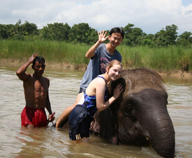
Our elephant and handler made sure that we not only gave a bath, but received a thorough dunking as well in the river.
In addition to TB work, he has performed many necropsies on electrocuted rhinos (fences put up by farmers to keep these wandering dinosaurs from pillaging their land) and man-eating tigers (he’s found fingers and human hair in their stomachs!). He invites any interested vet student to set up an internship with him during the summer- any interested readers can contact us for his contact information.
By Laurel Redding
Now that the VAHW training program is over, we’ve had a bit of a chance to reflect on the session. Training of paraprofessionals is something the veterinary community is very reluctant to do, both in the US, and, apparently, here too, despite the huge demand for basic livestock healthcare. A large majority of the Nepal directly depends upon agriculture and livestock for their livelihood, and many veterinary students choose to go abroad after vet school, yet the veterinary community is still hesitant to embrace the training of paraprofessionals for fear of losing business, and perhaps to some extent, for concern of inadequate veterinary care being given. Overall it seems, however, that VAHWs – or the equivalent – are a necessary and very promising way to improve animal health and productivity in rural areas.
The program of the VAHW training session covered an impressive array of topics – including basic handling and nutrition, different types of housing, basic anatomy and body systems, a range of diseases of concern in Nepal – including recognition of clinical signs and treatment. I am unsure of the depth of coverage of each topic and the amount knowledge retained by the VAHWs, but the training session did involve evaluations – oral quizzes every day, written tests every week, a final exam and final presentations given by trainees. Our research assistant Dr. Dipesh, taught a few lectures and mentioned that he would have liked a little more emphasis on diagnostic technique and that the coverage of diseases was very basic – perhaps this is all that is needed for VAHWs, but for veterinarians, it can certainly seem insufficient. Two examples illustrated this for me.
First, Dr. Dipesh at one point gave a lecture to trainees on milk fever. Milk fever is a disease cattle can get when they start lactation due to insufficient calcium reserves; the best way to deal with this is actually, counter-intuitively, to limit feeding calcium to cows during pregnancy, such that their bodies become used to mobilizing a limited calcium supply. Dr. Dipesh mentioned that the trainees had a very difficult time understanding the physiological processes involved, and that once he started talking about laboratory techniques, the group seemed to tune out. Another example was when a farmer brought a sick goat to the camp for treatment; he complained she was off-feed and, diagnostics were limited to taking the goat’s temperature and ausculting her rumen, and treatment consisted of giving her a bolus of an herbal appetite stimulant. 
It is clear that VAHWs are not trained as veterinarians, and their knowledge of animal health is very basic. However, many of the problems that affect health and productivity of livestock are basic – related to husbandry, nutrition, and treatable by simple improvements in these or vaccination, anthelmintics, etc. VAHWs can lead by example, instruct farmers in improved basic husbandry, nutrition, housing. Villages that were served by VAHWs generally had better cared-for and healthier animals. What’s more is that VAHWs are taught to recognize reportable diseases – Foot and Mouth Disease, Brucellosis, Avian Influenza – and report them to the relevant veterinary authorities, thus providing an essential network of eyes-and-ears on the ground. Moreover, VAHWs can increase their income through services rendered, and a large number of trained VAHWs go on to receive further veterinary training. And, because these VAHWs have a loyalty their community, they are more likely to stay around and provide valuable services to those who need it most. VAHWs are overall an excellent way to improve animal health and productivity in rural areas, and it was gratifying for us to be able to be a a part of this process.
Here is an example of a very basic but essential thing VAHWs can teach farmers about – mineral blocks, which contain iron, calcium and salts (made from dirt rich in iron, egg-shells and table salt), and provide some much-needed minerals animals may not otherwise get.
By Laurel Redding
Today was our last day in Pokhara and in Khalte-Mesina (the village where the VAHW training occurred). We were invited to attend and watch the village rice-planting. Since rice is the staple food here – as in most of Asia – this was an opportunity we could not pass up. The fields were down below the village, by the banks of the Seti River (which means “white river”, owing to the color of the sediment the river brings with it).
Mesina has two rice harvests a year, which, I was told, is not usual for all of Nepal. Mesina has the climate (temperate enough throughout the year) and enough water to allow for two plantings. Rice-planting is quite the community event. Most of the villagers have small plots of land – usually around 50-100 m2 – and all the villagers pitch in during planting time to get all the plots planted, a process which usually takes around one month.

The different steps of rice planting - first the field is tilled by oxen and manpower, then irrigated. The plants are then planted by the women of the village.
Those families that have oxen lend their animals to get all the fields tilled, and the younger men help out hoeing and digging the fields. From what I understood, the oxen plough the field, and the men dig up the field, placing dirt into raised barriers of sorts along the edges of the plots, such that the field where the crop goes are lower than the surrounding edges. The fields are irrigated, then the women plant the rice plants (which have been grown from seeds to small plants elsewhere). Rice is then available for harvest in about 5 months.

Rice-planting is definitely a celebratory event - even the oxen are blessed with tikas for the event. Yoon tries his hand at driving the oxen, with little success unfortunately!
Rice, I discovered, is somewhat like wine: there are subtle differences among types of rice that are well appreciated among connoisseurs (ie: those who eat rice every day). Similarly, aged rice is much finer than new rice. We were told that the best rice to eat is at least 6 months old – you only eat newly-harvested rice if you are very poor. All in all, it was an interesting experience to see the rice planting, especially since this is the dominant agricultural process that occurs throughout Asia.


